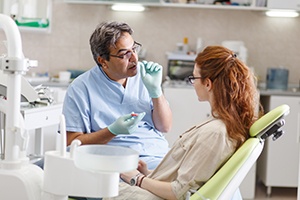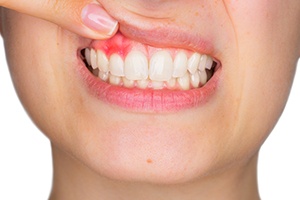Osseous Surgery for Worcester and Nearby Towns
 Osseous
surgery is an effective treatment for periodontal disease that has advanced to the point of threatening not only
gum tissue, but the bone as well. Also called pocket reduction surgery or gingivectomy, osseous surgery in
Worcester may be recommended in cases where non-surgical treatment such scaling and root planing would not be
sufficient to stop the advance of bacteria that have invaded the area. Left untreated, periodontitis can lead to
tooth loss.
Osseous
surgery is an effective treatment for periodontal disease that has advanced to the point of threatening not only
gum tissue, but the bone as well. Also called pocket reduction surgery or gingivectomy, osseous surgery in
Worcester may be recommended in cases where non-surgical treatment such scaling and root planing would not be
sufficient to stop the advance of bacteria that have invaded the area. Left untreated, periodontitis can lead to
tooth loss.
When is Osseous Surgery Necessary?
 Osseous surgery
is needed only when non-surgical treatment is not an option. Most people are able to keep their teeth and gums
healthy with daily oral hygiene that is founded on brushing with fluoride toothpaste and flossing. This practice
helps remove plaque, the bacterial film that causes gum disease. Professional dental cleanings are also
advisable in order to remove bacterial deposits below the gum line.
Osseous surgery
is needed only when non-surgical treatment is not an option. Most people are able to keep their teeth and gums
healthy with daily oral hygiene that is founded on brushing with fluoride toothpaste and flossing. This practice
helps remove plaque, the bacterial film that causes gum disease. Professional dental cleanings are also
advisable in order to remove bacterial deposits below the gum line.
Normally, gum and bone tissue fit snuggly around your teeth. However, as periodontal disease advances, gum tissue begins to pull away from teeth, exposing more of the root and creating what are called gum pockets. As these pockets deepen over time, there is room for more bacteria. Eventually, bacteria invade below the gum line, causing further gum and bone tissue loss. In this case, osseous surgery is needed to remove bacteria and prevent further damage or even tooth loss.
What is Osseous Surgery?
 Osseous surgery is
performed by a periodontist in Worcester. It is a minor surgery done under local anesthetic. Once the area is
numb, just enough gum tissue is folded back away from the tooth so that the diseased root surfaces are visible.
Osseous surgery is
performed by a periodontist in Worcester. It is a minor surgery done under local anesthetic. Once the area is
numb, just enough gum tissue is folded back away from the tooth so that the diseased root surfaces are visible.
Then, bacterial deposits that have hardened onto the tooth can be removed. Next, the tooth is smoothed and reshaped, and the bone is re-contoured in order to eliminate gum pockets. Finally, gum tissue is put back into place and closed with stitches. A dressing is usually placed over the site to keep the area undisturbed, at least for the first several days after surgery.
The doctor and his staff will send you home with detailed instructions on how to care for the surgical site, how to alleviate discomfort and swelling and how to maintain a nutritious diet that will promote healing and reattachment of gum tissue to your teeth.
Does Osseous Surgery Cure Periodontal Disease?
Unfortunately, the answer to that question is no. The bacteria that started the problem will still be present in your mouth. Therefore, a stringent oral hygiene routine at home is essential. In particular, bacteria must be kept off teeth that have been treated with surgery so that reattachment and healing can happen. That’s why excellent home care and several post-operative visits are required.
Osseous Surgery FAQs
 Osseous surgery can be critical for protecting your smile from gum disease. You’ll be in good hands for
the procedure thanks to our knowledgeable team that’s fully committed to meeting the needs of every
patient. Is there anything you would like to know about osseous surgery before having it performed? Simply reach
out to us to ask your questions about this procedure. But first, check the FAQs below to see if you can find the
information you’re looking for.
Osseous surgery can be critical for protecting your smile from gum disease. You’ll be in good hands for
the procedure thanks to our knowledgeable team that’s fully committed to meeting the needs of every
patient. Is there anything you would like to know about osseous surgery before having it performed? Simply reach
out to us to ask your questions about this procedure. But first, check the FAQs below to see if you can find the
information you’re looking for.
How Long Does It Take to Recover from Osseous Surgery?
It usually takes most patients a week or two for the mouth to feel back to normal after osseous surgery.
How Do You Prepare for Osseous Surgery?
To make sure your osseous surgery goes as smoothly as possible, we’ll instruct you to:
- Take any medications that we prescribe.
- Avoid aspirin and other blood-thinning medications after a certain date.
- Eat before your procedure. (Your mouth will be tender after your treatment, which will make eating difficult.)
- Make arrangements to have someone else drive you home after your appointment. (This will only be necessary if oral conscious sedation or IV sedation will be used.)
- Stay away from cigarettes and alcohol for at least a full day before and after your procedure.
Please let us know right away if you don’t fully understand any instructions you’ve received; it’s essential that you give your mouth the right kind of care in the days following your osseous surgery.
Is Osseous Surgery Painful?
As with any surgical procedure, the first step of osseous surgery is to numb your mouth. As such, there’s very little discomfort associated with the actual treatment. There may be some soreness after your procedure, but it should go away after a few days. Inform us immediately if your pain doesn’t seem to be improving over time; we’ll need to identify the problem so that it can be dealt with appropriately.
You should avoid eating anything while your mouth is still numb. Otherwise, you could end up biting your lip or your tongue without even realizing it, which can result in serious discomfort once the local anesthetic has fully worn off.
Can You Go Back to Work After Osseous Surgery?
You should return home and rest after osseous surgery. In many cases, it may be possible for you to go back to work the following day. However, people with jobs that involve any sort of strenuous physical activity should plan on taking several days off; if you push yourself too hard, it could make your post-operative discomfort worse, and it may even lead to additional swelling or bleeding.

